(click on photos to enlarge image)
NUMERATION IN SILVER-PLATED CHRISTOFLE HOLLOW WARE
AND ITS APPLICATION TO ITEMS DATING
It is a remarkable fact that every relatively large piece of
hollow ware, issued by the famous French silversmith foundry
Christofle in 1846-1930, possesses a so-called numbering, i.e.,
each item is marked by its own ordinal number
(Literature: 1). No other company in the world made such
marking. Indeed, Christofle had even two numberings. The first
one was used from c.1846 until 1862
(Literature: 2) (or, according to
(Literature: 3, 4), until 1865) and was running from 1 up to
at least 337243, which is engraved on the bottom of a small
Christofle coffee-pot from my collection (Fig.1).
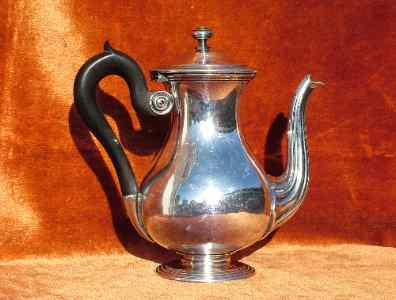 |
 |
Fig.1: A coffee-pot, issued c.1862, and its
ordinal number
|
After the change of the Christofle mark in 1862/1865 the
second numeration started, that continued until a number which
was very near to 3000000 (three millions). I have in my
collection a tea-pot with the inscription "Grand Hotel du
Louvre" and the ordinal number 2993546, see Fig.2.
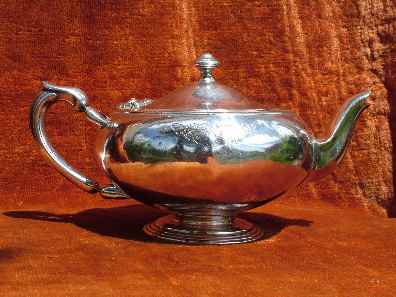 |
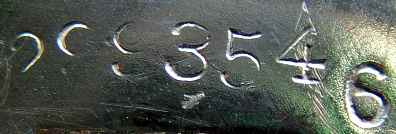 |
Fig.2: A teapot with the inscription "Grand
Hotel du Louvre",
issued c.1930, and its ordinal number
|
In the last few years I was permanently trying to correlate
the Christofle ordinal numbers to the real years of issue. The
main problem was the lack of a sufficient number of the
reference items containing the date of production. Now this
problem is solved as I have enough reference items which allowed
me to build a mathematical model connecting the production year
and the ordinal number.
In 2006 I was lucky to purchase a couple of dated milk cans,
bearing the numbers 1774104 and 1776073, both signed by the
inscription "Salzburg 98" (Fig.3). I supposed that these
milk cans with a number 1.77 million
(1.77 M) were made in 1898 or a little earlier. Some of my
colleagues argued that the inscription "Salzburg 98" might be "a
model name and number". I did not agree with that comment, as
French people of that period would never name their hollow ware
model by the name of an Austro-Hungarian (or Bavarian) city.
There are some Christofle models, named after French places like
"Malmaison" or "Marly", this is possible, but certainly not "Salzburg".
Later, I saw in Internet an auction for the silver-plated trophy
produced for the Arles Regional Agriculture Competition
organized by the Ministry of Agriculture (Ministere de L’Agriculture Concours
Regional Agricole d’Arles) in 1899; that trophy was bearing the ordinal number of
1818091 (Fig.4), thus confirming the dating of my "Salzburg 98"
milk cans.
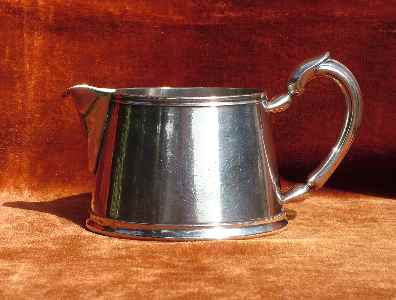 |
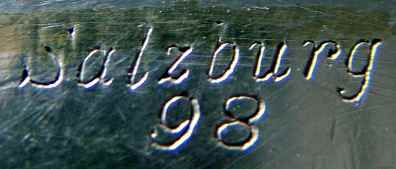 |
 |
Fig.3: A milk can with the inscription "Salzburg
98"
and its
ordinal number
|
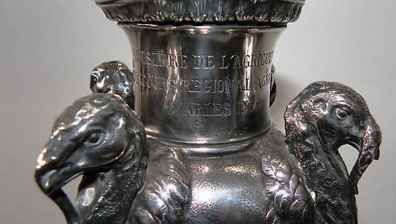 |
 |
Fig.4: An agricultural trophy with four turkeys made in 1899
and its ordinal number
|
Very recently, I bought two dishes with the numbers 2943686
and 2943692, both dishes have the same inscription "Albion
Palais des Alpes 1928" (Fig.5).
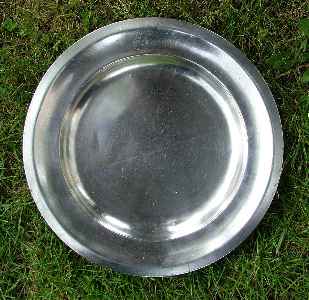
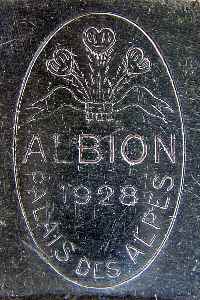 |
 |
Fig.5: A dish with the inscription "Albion
Palais des Alpes 1928"
and its ordinal number
|
The following important information on this matter was
kindly given me by Professor Marc de Ferrière le Vayer
(Literature: 5). The object with the number 1370632 was
produced between December 1887 and January 1889; the item with
the number 1502505 was produced between December 1890 and
December 1891; the item with the number 1776073 was issued
between April 1898 and February 1899.
With all this data it was possible to plot a graph and fit it
with a quadratic polynomial function (Fig.6). This graph gives
the dependence for the second numbering (Y) versus time period
in years since the starting point (X) together with the
approximating quadratic function. For the starting point either
1862 or 1865 could be used, however, the plot for 1862 showed
better correlation between the experimental points while fitting
and therefore was chosen as a final one. The time period (X) was
calculated since the end of June 1862 (middle point in the year
1862). Everybody with basic algebra knowledge can easily
calculate the corresponding numbering for any year between 1846
and 1930 using the expression given in Fig.6.
It should be emphasized that the smooth curve on Fig.6 is only
an approximation to the real dependence. Certainly, during the
long history of the Christofle foundry there were periods with
higher production efficiency (e.g., due to the opening of new
branches) or periods of decline (e.g., due to the war).
Nevertheless, this graph is still quite useful.
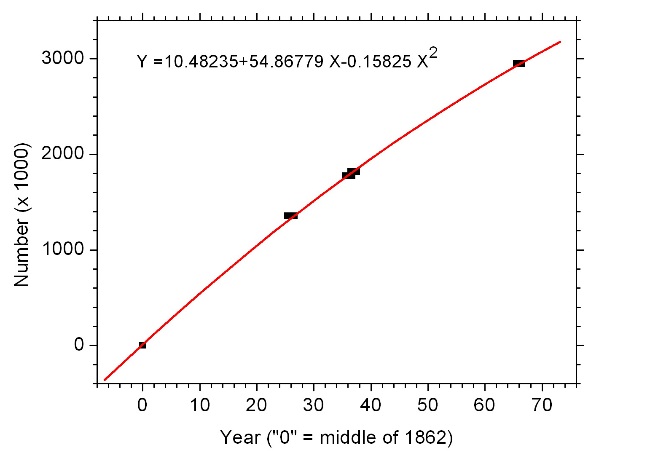 |
Fig.6: Dependence of the ordinal number on
the time period
since the middle of 1862
|
In Table 1 the results for the reverse problem, namely, how
to calculate a production year (how to date the item with the
second Christofle mark), starting from the number on the object,
are given. The total uncertainty (accuracy) in the year
determination is about 3 years or less.
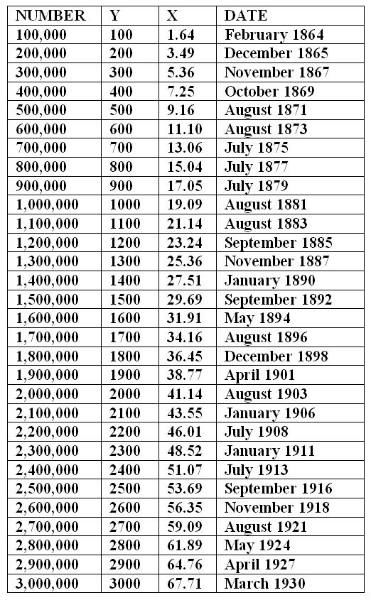 |
Table 1: Correlation between the ordinal
number and the production time
between 1862 and 1930
|
Now we will turn our attention to the first numbering which
started somewhere after 1844 (I have in my collection a piece
with first mark without any numeration) and finished in the
middle of 1862 (as we have just established). According to the
information kindly supplied by Prof. Marc de Ferrière
(Literature: 5), the Christofle Museum purchased a set of
hollow ware made by Christofle for king Louis-Philippe and in
this set each piece had its ordinal number starting with 1. It
is known that in 1847, Charles Christofle was appointed
Fournisseur Officiel du Roi Louis-Philippe (Official Purveyor of
the king) and, therefore, it is logical to suggest that the
first numbering started sometime in 1846. Another priceless
piece of information, obtained from Marc de Ferrière, was the
dating of one hollow ware item with the first Christofle mark:
the object with the number 149240 was produced between December
1857 and March 1859.
Using all this data, I again plotted a graph and fit it with a
quadratic polynomial function (Fig.7). This graph gives the
dependence for the first numbering (Y) versus time period in
years since the starting point (X) together with the
approximating quadratic function. The time period (X) was
calculated since the end of June 1846 (middle point inside the
year 1846).
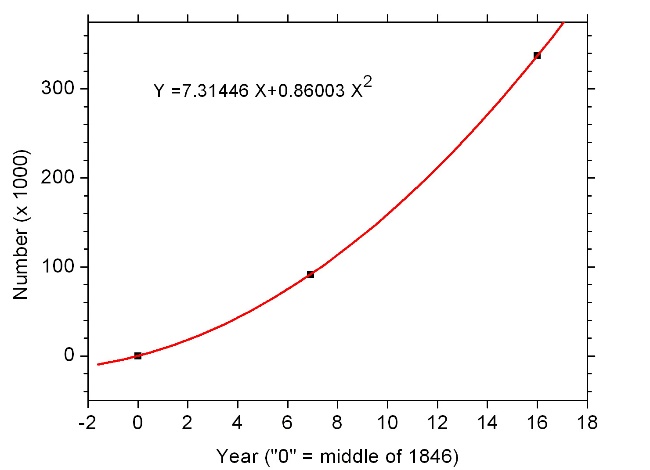 |
Fig.7: Dependence of the ordinal number on
the time period
between the middle of 1846 and the middle of
1862
|
In Table 2 the results for the reverse problem, namely, how
to calculate a production year (how to date the item with the
first Christofle mark), starting from the number on the object,
are given. The total uncertainty (accuracy) of year
determination is about 3 years or less.
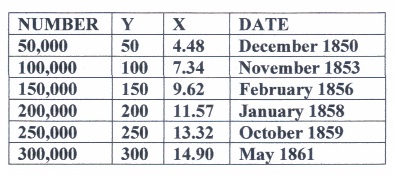 |
Table 2: Correlation between the ordinal
number and the production time
between 1846 and 1862
|
The author is indebted to Professor Marc de Ferrière le
Vayer, former director of the Christofle Museum in Saint-Denis,
Paris, for the priceless information and invaluable discussions.
The author is also thankful to André Van den Kerkhove, Honorary
Director of the Historical Museum of the Byloke of the City of
Ghent, Belgium, for his courtesy.
LITERATURE
1. David N. Nikogosyan, An unknown mark for silver-plated
hollow ware used by Christofle in 1930-1935,
http://www.ascasonline.org/articoloGIUGN130.html
2. Marc de Ferrière, Christofle: 150 ans d’Art et de Rève.
Dossier de l’Art, No.2, pp.3-73 (1991), [in French].
3. André Van den Kerkhove, private communication.
4. Walter van Dievoet, Dictionnaire des Orfèvres et
Bijoutiers de Bruxelles et des arrondissements de Nivelles et de
Hal-Vilvorde au XIXe siècle, Louvain, 2003, pp.1-485, [in French].
5. Marc de Ferrière le Vayer, private communication.
Prof. David N. Nikogosyan,
University College Cork, Cork, Ireland
- 2010 -
|
|
 ASSOCIATION OF SMALL COLLECTORS OF ANTIQUE SILVER
ASSOCIATION OF SMALL COLLECTORS OF ANTIQUE SILVER













